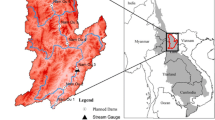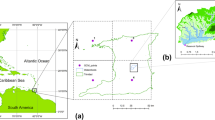Abstract
The transboundary Sesan and Srepok sub-basins (2S) are the “hot-spot” areas for reservoir development in the Lower Mekong region, with 12 reservoirs built in the Vietnam territory. This study examines the impacts of reservoir operations in Vietnam and projected climate change on the downstream hydrologic regime of the 2S Rivers by jointly applying the Soil Water Assessment Tool (SWAT) and Water Evaluation and Planning (WEAP) models. Different scenarios of reservoir operation are considered and simulated to assess their impact on annual, seasonal, and monthly flow regimes under maximum hydropower capacity generation with and without taking into account the minimum flow requirement downstream near the Vietnam border with Cambodia. The precipitation and temperature projections from the high-resolution regional climate model HadGEM3-RA under two Representative Concentration Pathways, 4.5 and 8.5, of HadGEM2-AO are used as future climate change scenarios for the impact assessment. The study results show that reservoir operation leads to an increase in the dry season stream flows and a decrease in the wet season stream flows. The monthly flow regime exhibits considerable changes for both the Sesan and Srepok Rivers but with different magnitudes and patterns of increase and decrease. Climate change is likely to induce considerable changes in stream flows, though these changes are comparatively lower than those caused by reservoir operation. Climate change is likely to have both counterbalancing and reinforcing effects over the impact of reservoir operation, reducing changes during dry season but increasing changes in most of the other months.





Similar content being viewed by others
References
Boé J, Terray L, Habets F, Martin E (2007) Statistical and dynamical downscaling of the Seine basin climate for hydro-meteorological studies. Int J Climatol 27:1643–1655. doi:10.1002/joc.1602
GSO-General Statistics Office of Vietnam (2013) Statistical Year Book of Vietnam. (In Vietnamese)
Gudmundsson L, Bremnes JB, Haugen JE, Engen-Skaugen T (2012) Technical Note: Downscaling RCM precipitation to the station scale using statistical transformations—a comparison of methods. Hydrol Earth Syst Sci 2012(16):3383–3390. doi:10.5194/hess-16-3383-2012
Hoanh, CT, Jirayoot, K, Lacombe, G, and Srinetr, V (2010) Impacts of climate change and development on Mekong flow regimes: first assessment—2009. Technical Paper No. 29, Mekong River Commission, Vientiane, Lao PDR
Lauri H, de Moel H, Ward PJ, Rasanen TA, Keskinen M, Kummu M (2012) Future changes in Mekong River hydrology: impact of climate change and reservoir operation on discharge. Hydrol Earth Syst Sci 16(12):4603–4619
MRC (2012) Update of Sub-Area profile sub-area 7V—final Report. BDP Programme
Piani C, Weedon GP, Best M, Gomes SM, Viterbo P, Hagemann S, Haerter JO (2010) Statistical bias correction of global simulated daily precipitation and temperature for the application of hydrological models. J of Hydrol 395(3–4):199–215
Piman T, Cochrane TA, Arias ME, Green A, Dat ND (2013) Assessment of flow changes from hydropower development and operations in Sekong, Sesan and Srepok Rivers of the Mekong Basin. J Water Resour Plan Manag 139(6):723–732
Piman T, Cochrane TA, Arias ME, Dat ND, Vonnarart O (2015) Managing hydropower under climate change in the Mekong tributaries. In: Shrestha S, Anal AK, Salam PA, van der Valk M (eds) Managing Water Resources under Climate Uncertainty: Opportunities and Challenges: 223–248. Springer, London. doi:10.1007/978-3-319-10467-6_11, Chapters in Books
Räsänen T, Joffre O, Someth P, Thanh C, Keskinen M, Kummu M (2015) Model-based assessment of water, food, and energy trade-offs in a cascade of multipurpose reservoirs: case study of the Sesan tributary of the Mekong River. J Water Resour Plann Manage 141(1):05014007
SEI (2011) WEAP Water Evaluation And Planning System. User Guide. Stockholm Environment Institute, U.S. Center
Teutschbein C, Seibert J (2010) Regional climate models for hydrological impact studies at the catchment scale: a review of recent modeling strategies. Geography Compass 4:834–860. doi:10.1111/j.1749-8198.2010.00357.x
VPM-Vietnamese Prime Minister (2014) Operation rules for reservoir system in Sesan river. Decision of Vietnam’s Prime Minister No 1182/QĐ-TTg. (In Vietnamese)
VPM-Vietnamese Prime Minister (2014) Operation rules for reservoir system in Srepok river. Decision of Vietnam’s Prime Minister No 1201/QĐ-TTg. (In Vietnamese)
Winchell M, Srinivasan R, Di Luzio M, Arnold JG (2010) Arc-SWAT Interface For SWAT 2009: User’s Guide. Texas Agricultural Experiment Station (Texas) and USDA Agricultural Research Service (Texas), Temple (Texas)
Acknowledgements
This research was carried out under the funding of the Post-Graduate Research Programme on Adaptation to Climate Change (PRoACC) with special focus on the Mekong River Basin—Phase 2, with the research facility under the DGIS (Dutch Development Cooperation)-UNESCO-IHE Programmatic Cooperation (DUPC). The authors wish to thank PRoACC team members for their support and useful insights.
We acknowledge the CORDEX-East Asia Databank, which is responsible for the CORDEX dataset, and we thank the National Institute of Meteorological Research (NIMR), three universities in the Republic of Korea (Seoul National Univ., Yonsei Univ., Kongju National Univ.), and other cooperative research institutes in East Asia region for producing and making available their model output.
Author information
Authors and Affiliations
Corresponding author
Additional information
This article is part of a Special Issue on “Climatic Change and Development in the Mekong River Basin” edited by Jaap Evers and Assela Pathirana.
Rights and permissions
About this article
Cite this article
Ngo, L.A., Masih, I., Jiang, Y. et al. Impact of reservoir operation and climate change on the hydrological regime of the Sesan and Srepok Rivers in the Lower Mekong Basin. Climatic Change 149, 107–119 (2018). https://doi.org/10.1007/s10584-016-1875-y
Received:
Accepted:
Published:
Issue Date:
DOI: https://doi.org/10.1007/s10584-016-1875-y




